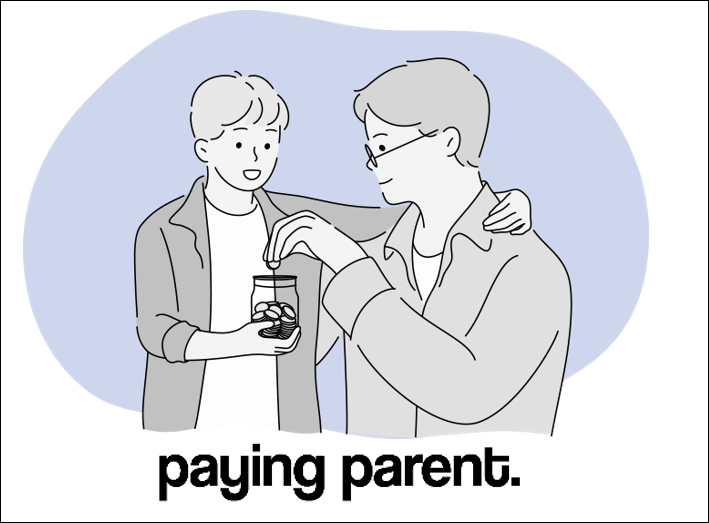
When parents separate, ensuring that children are financially supported becomes a top priority. In the UK, the Child Maintenance Service (CMS) plays a crucial role in this process. But for many dads, navigating the CMS can feel overwhelming. This guide is here to simplify things and help you understand what to expect from start to finish.
Step 1: Understanding the Child Maintenance Service
The CMS is a government agency responsible for making sure non-resident parents (often dads) contribute financially to their children’s upbringing. It provides a fair system for calculating, collecting and distributing payments.
There are two main ways to arrange child maintenance:
- Family-Based Arrangement: You and your ex-partner agree on payment terms without involving the CMS. This option works best if both parents can communicate effectively.
- CMS Arrangement: If an agreement can’t be reached, the CMS steps in. They calculate the payments and can manage them through:
- Direct Pay: CMS calculates the amount, but payments are made directly between parents.
- Collect and Pay: CMS collects and transfers payments (for a fee) when parents are unable to manage it themselves.
If you need more information on CMS arrangements, check out other resources available from support groups like Paying Parent.
Step 2: Starting the CMS Process
Once separation occurs, it’s important to set up a child maintenance agreement as soon as possible. Here’s what happens if you involve the CMS:
- Application: The Resident Parent applies for CMS services, either online or by phone. The application fee is £20, but some are exempt (e.g. victims of domestic abuse).
- Initial Contact: CMS will contact both parents to verify details. This process takes a few weeks as they gather all necessary information.
Step 3: CMS Payment Calculation
Once CMS has the required details, they calculate the maintenance payments based on:
- Income: Your gross income (including wages and benefits) is the main factor in determining the payment amount. This is automatically collected from HMRC and is usually based on your most recent annual income.
- Number of Children: The more children you have, the higher the payment will be.
- Shared Care: If your children stay with you for a portion of time, this will potentially reduce the amount you owe.
The CMS uses a formula to ensure that payments are fair and proportionate. You’ll receive a calculation notice outlining the amount to be paid and the payment schedule. If you think the calculation is incorrect (which happens more often than you might expect), you have one month to dispute it.
Step 4: Handling Disputes
Disputes can arise, particularly regarding the calculation of payments or the non-payment of agreed amounts. Here’s how to handle them:
-
- Communicate Directly: If you and the other parent can discuss the issue calmly, try to resolve it directly. Clear communication can often prevent misunderstandings from escalating.
- Contact the CMS: If direct communication doesn’t work, contact the CMS. They can mediate disputes, verify income and adjust payments if necessary. When calling, be prepared for significant wait times, especially during peak hours. The CMS offers a triage service where your issue will be assessed and directed to the appropriate department and/or case worker.
- File a Formal Complaint: If you believe the CMS has made an error, you can lodge a formal complaint. The CMS has a dedicated process for handling complaints, and they are obligated to review and respond to your concerns. For Paying Parent members, more information on this complicated process is available in your members area of our website, including templates and guidance documents, find it here.
Step 5: Using the CMS Online Self-Service Portal
The CMS online self-service portal is an essential tool for managing your child maintenance case. Here’s how to make the most of it:
- Register: After your case is set up, you’ll receive instructions for registering on the portal. Keep your case number and personal details handy.
- Manage Payments: The portal allows you to view your payment schedule, track payments, and update financial information if your circumstances change.
- Communicate: You can message the CMS directly through the portal, which helps you keep track of correspondence.
- Resolve Disputes: If you need to dispute a payment or report a missed one, you can do so via the portal for quicker resolution.
Make sure to log in regularly to stay on top of any updates or requests.
Step 6: Closing the CMS Case
A child maintenance case typically stays open until your child turns 16 (or up to 20 if they’re still in full-time education, excluding university). However, a case may close earlier if both parents agree to a private arrangement or if the paying parent’s circumstances change significantly.
When the case is ready to close, the CMS will notify you. Ensure all payments are up to date and any disputes are resolved before the case officially closes.
Tips for Navigating the CMS
- Stay Organised: Keep records of all communications, payments, and documents related to your case. This can save you time and stress if disputes arise.
- Be Proactive: If your financial situation changes, inform the CMS immediately to avoid falling into arrears.
- Get Support: Navigating the CMS can be tough, especially during emotionally charged times. Reach out to support groups or legal professionals if you need advice.

Conclusion
The CMS process can be complex, but with the right information, you can navigate it more smoothly. By staying organised and proactive, you can ensure your child gets the support they need without unnecessary stress. Remember, the goal is to provide for your child, and the CMS is there to help facilitate this, ensuring that both parents contribute to their child’s well-being.
How can www.payingparent.co.uk help dads manage this?
The Paying Parent platform has been created purely and simply to provide dads with all the necessary tools and knowledge they’ll need. They’ll be able to manage their child maintenance agreement with ease and confidence. Here’s some of the benefits of becoming a member:
Calculate exactly how much child maintenance you need to pay – taking into account any special expenses. We’ve built our PP Child Maintenance Calculator to match exactly how the CMS calculate your payments. Try it out!
Plan for your future by working out how much your payments will change if you:
- Get a pay rise/new job
- Have a baby with a new partner
- Have your children stay overnight more/less often
Follow our useful guidance on how to reduce your payments, whilst using our special expenses claim form
Get the support you need to appeal a decision made by the Child Maintenance Service
Use our templates to take the stress out of communicating with your ex-partner, legal representatives and the Child Maintenance Service – designed to save you time and money
Access our ‘Child Maintenance Dos and Don’ts’ – a detailed guide full of top tips to help you navigate your child maintenance arrangement
Network with other Dads experiencing the same issues, ask questions and share your experiences via our members-only platform
Learn about some of the most common (and some of the not so common) situations you’re likely to encounter as part of your child maintenance journey, and how to overcome them.
Head to www.payingparent.co.uk to find out more!








